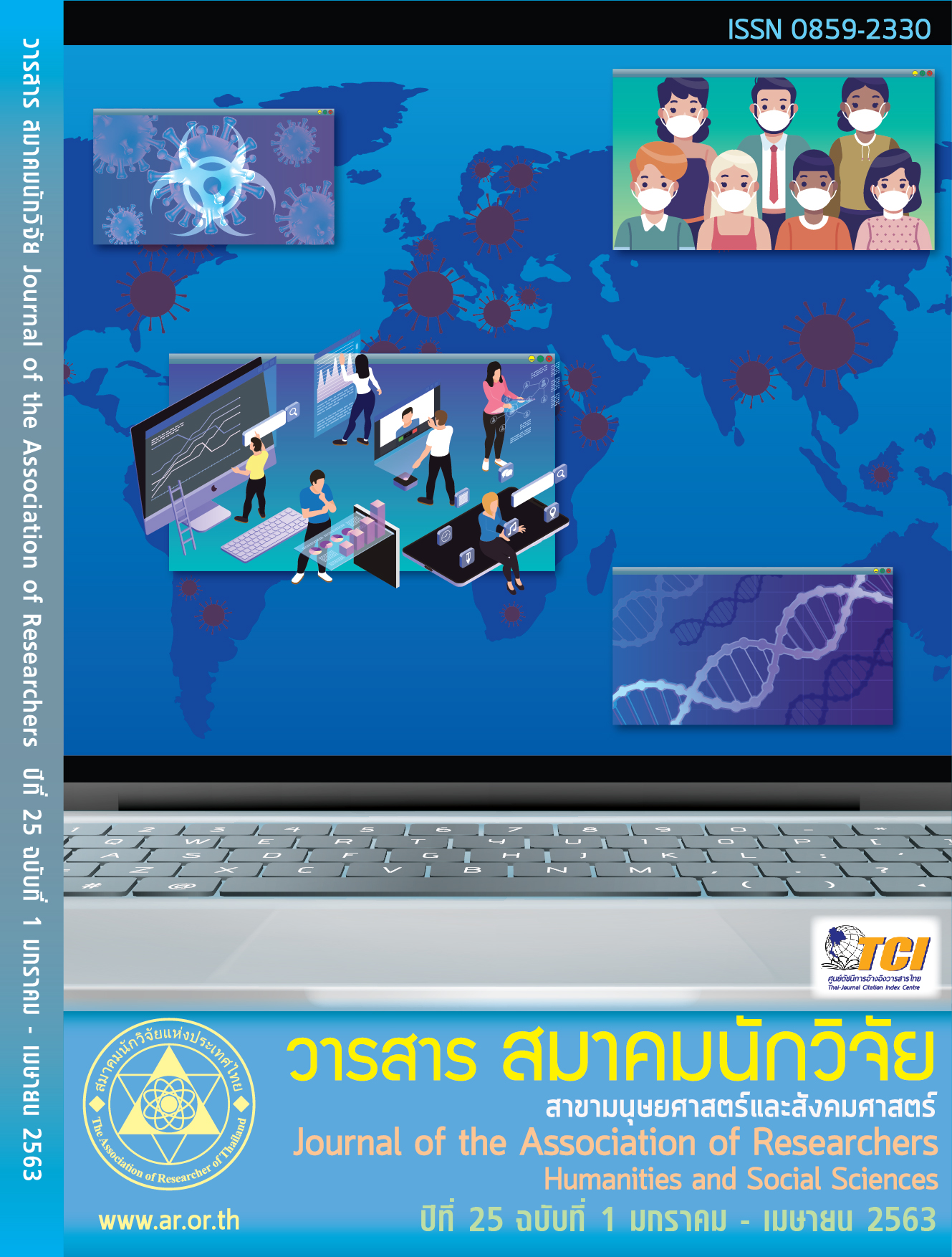Emission Source Impact and Problem Solving and Management on PM 2.5 in the Northern part of Thailand.
Main Article Content
Abstract
The research aimed to study on the emission sources, impact and problem solving and management on PM 2.5 in the northern part of Thailand. The study was based on the secondary data analysis method. The 15 original research papers which were on the TCI, ISI level and government research report and articles. The results from all the research articles were carefully analyzed. The results showed that the source of PM 2.5 were firstly generated from outdoor burning.
And secondary was wildfire which was occurred in the country and neighboring countries. The impacts of PM 2.5 were in the economic health and environment. The ways to solve all the problem above was in the short term were prevention and control such as knowledge and informations the problems and impact of PM 2.5 on economic, environment and health were quickly informed. Moreover, the government section should set and announce the standard and process to prevent control and solve the problem in the long term.
Article Details
บทความที่ปรากฏในวารสารนี้ เป็นความรับผิดชอบของผู้เขียน ซึ่งสมาคมนักวิจัยไม่จำเป็นต้องเห็นด้วยเสมอไป การนำเสนอผลงานวิจัยและบทความในวารสารนี้ไปเผยแพร่สามารถกระทำได้ โดยระบุแหล่งอ้างอิงจาก "วารสารสมาคมนักวิจัย"
References
ขจรศักดิ์ โสภาจารีย์ และเพชร เพ็งชัย. (2550). โครงการการสำรวจปริมาณฝุ่นในอากาศภายในจังหวัดชียงใหม่และจังหวัดลำพูน. รายงานวิจัยฉบับสมบูรณ์. สำนักงานกองทุนสนับสนุนการวิจัย(สกว.).
จินตนา ประชุมพันธ์. (2561). PM 2.5 ฝุ่นละอองขนาดเล็กในอากาศ กับวิกฤตสุขภาพที่คนไทยจะต้องแลก[ออนไลน์]. จาก https://thestandard.co/pm-2-5-environmental-nano-pollutants/. เข้าถึงเมื่อ 20 มีนาคม 2019.
เฉลิม ลิ่วศรีสกุล, แสงนวล ตุงคณาคร และอัชนา เลียวหิรัญ. (2545). ปัญหามลพิษทางอากาศต่อการทำงานของปอด: การศึกษาในตำรวจจราจรในเมืองเชียงใหม. เชียงใหม่เวชสาร. 41(2): 89-94.
ทิพวรรณ ประภามณฑล และคณะ. (2554). สาเหตุการเกิดฝุ่นและภาวะหมอกควันในชุมชนและข้อมูลฝุ่น พีเอ็ม 10. ศูนย์วิจัยด้านมลภาวะและอนามัยสิ่งแวดล้อม สถาบันวิจัยวิทยาศาสตร์สุขภาพ มหาวิทยาลัยเชียงใหม่.
ธันยพร บัวทอง. (2562). ฝุ่น : เชียงใหม่ วิกฤตหมอกควันภาคเหนือ วาระแห่งชาติที่ยังแก้ไม่ได้มา 12 ปี.
เผยแพร่เมื่อ 13 มีนาคม 2019. [ออนไลน์]. จาก https://www.bbc.com/thai/thailand-47550696. เข้าถึงเมื่อ 20 มีนาคม 2019.
ฐิฏาพร สุภาษี , พานิช อินต๊ะ, เสริมเกียรติ จอมจันทร์ยอง และเศรษฐ์ สัมภัตตะกุล. (2561). การวิเคราะห์ปริมาณฝุ่นละอองเชิงมวล PM2.5 และ PM10 ในบรรยากาศด้วยเครื่องตรวจวัดฝุ่นละอองไร้สายในพื้นที่ภาคเหนือของประเทศไทย. วารสารวิจัยเทคโนโลยีนวัตกรรม. 2(1), มกราคม-มิถุนายน, 69-83.
สมพร จันทระ, ชาคริต โชติอมรศักดิ์ และว่าน วิริยา. (2561). การติดตามตรวจสอบการเผาในที่โล่งในภาคเหนือของประเทศไทย สำหรับการประเมินการปล่อยและการเคลื่อนที่ของมลพิษทางอากาศเพื่อการวางแผนการจัดการปัญหาหมอกควัน. รายงานวิจัยฉบับสมบูรณ์. สำนักงานกองทุนสนับสนุนการวิจัย(สกว.).
สำนักงานสิ่งแวดล้อมภาคที่ 1 (เชียงใหม่). 2561. สรุปสถานการณ์หมอกควันและไฟป่า 2561 (เชียงใหม่ เชียงราย ลำพูน แม่ฮ่องสอน). กระทรวงทรัพยากรธรรมชาติและสิ่งแวดล้อม. กันยายน 2561.
สำนักงานพัฒนาเทคโนโลยีอวกาศและภูมิสารสนเทศ (องค์การมหาชน). 2561. สรุปสถานการณ์ไฟป่าและหมอกควัน ด้วยภาพถ่ายจากดาวเทียม ประจำปี 2561 ระหว่างวันที่ 1 มกราคม ถึง 31 พฤษภาคม 2561. กระทรวงวิทยาศาสตร์และเทคโนโลยี, สิงหาคม. 2561.
รัตนศิริ กิตติก้องนภางค์. (2019). มีอะไรใต้หมอกควัน PM 2.5 ภาคเหนือ. เผยแพร่เมื่อ 19 มีนาคม 2019. [ออนไลน์]. จาก https://www.greenpeace.org/thailand/story/4769/north-pm25/ เข้าถึงเมื่อ 20 มีนาคม 2019.
รัตนศิริ กิตติก้องนภางค์. (2019). ภาพที่ชัดในวันที่ฝุ่นลง. เผยแพร่เมื่อ 7 มีนาคม 2019. [ออนไลน์]. จาก https://www.greenpeace.org/thailand/story/2019/why-aqi-is-important/ เข้าถึงเมื่อ 10 มีนาคม 2019.
อุษณีย์ วินิจเขตคำนวณ และขนิษฐา พันธุรีฒ. (2550). รายงานวิจัยโครงการการพัฒนาชุดความรู้ด้านประสิทธิภาพของหน้ากากป้องกันฝุ่นขนาดเล็ก. รายงานวิจัยฉบับสมบูรณ์. สำนักงานกองทุนสนับสนุนการวิจัย (สกว.).
Anuttara, H., Yanasinee, S., Nittaya, P., and Vivat, K. (2017). Analysis of Air Quality Impacts on HumanHealth Using the Geoinformatics Application: Chiang Rai Province. Applied Environmental Research. 39(3), 25-32.
Kim Oanh. (2017). A Study in Urban Air Pollution Improvement in Asia AIT. Research Project submitted to JICA-Research Institute, Asian Institute of Technology. October.
Translated Thai References
Department of Pollution Control. (2018). The study of origin and guidelines for the management of dust particles of not more than 2.5 micron in Bangkok and its surrounding areas. Bangkok: Air and Noise Management Division, Ministry of Natural Resources and Environment. (In Thai).
Khajornsak Sopajaree, Petch Pengchai. (2007). Investigation of Particulate Matters in Chiang Mai and Lumphun Ambient Air. Full Research Report, Thailand Science Research and Innovation. (In Thai).
Chintana Prachumphan. (2018). PM 2.5 Small dust in the air with the health crisis that Thai people have to exchange. Online: https://thestandard.co/pm-2-5-environmental-nano-pollutants/. Access in 20 March, 2019. (In Thai).
Chalerm Liwsrisakun. Saengnuan Tungkanakorn and Ashana Leowhiran. (1992). Air pollution proble in Lung Function : Case study of traffic police in Chiang Mai. Chiang Mai medical bulletin, 41(2): 89-94. (In Thai).
Thiphawan Phaphamonthon and et al. (2011). Causes of dust and haze in the community and particulate matters. Knowledge Book-1, Research Institute for Health Sciences, Chiang Mai University. (In Thai).
Thanyaphon Buathong. (2019). Air Pollution as National Agenda in Chiang Mai has been unsolved for over 12 years. Published online: 13 March, 2019. Online: https://www.bbc.com/thai/thailand-47550696., Access in 20 March, 2019. (In Thai).
Titaporn Supasri, Panich Intra, Sermkiat Jomjunyong and Sate Sampattagul. (2018). Evaluation of Particulate Matter Concentration by Using a Wireless Sensor System for Continuous Monitoring of Particulate Air Pollution in Northen of Thailand. Journal of Innovative Technology Research. Vol.2 No.1, January-June 2018. (In Thai).
Somporn chantara, Chakrit Chotamonsak and Wan Wiriya. (2018) Investigation of monitor and classify biomass burning area in nine provinces of Northern Thailand to assess pollutant distribution and moving of air pollutant for planning to Particulate Matter Smog. Full Research Report, Thailand Science Research and Innovation. (In Thai).
Regional Environment Office 1 (Chiang Mai). (2018). Sunnary of haze and forest fires in 2018 (ChiangMai, Chiang Rai, Lamphun Mae Hong Son). Ministry of Natural Resources and Environment. September, 2018. (In Thai).
Geo-Informatics and Space Technology Development Agency (Public Organization). (2018). Summary of the forest fire situation and Smog with satellite images of the year 2018 to 31 May. Ministry of Science and Technology. August 2018. (In Thai).
Rattanasiri Kittikongnapang. (2019). Anything under the PM 2.5 Northern region. Published online: 19 March, 2019. Online:https://www.greenpeace.org/thailand/story/4769/north-pm25/. Access in 20 March, 2019. (In Thai).
Rattanasiri Kittikongnapang. (2019). A clear picture on a dusty day. Published online: 7 March, 2019. Online: https://www.greenpeace.org/thailand/story/2019/why-aqi-is-important/ .Access in 10 March, 2019. (In Thai).
Usanee Winitkhetkhamnun and Khanittha Phanthirat. (1997). The development of a knowledge book on the efficiency of small dust masks. Full Research Report, Thailand Science Research and Innovation. (In Thai).


